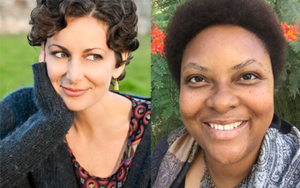
Anna Jackson, MSSW, Founder, Alpinista Consulting and Nakia Winfield, LMSW, Equity Consultant, Independent
This is a guest post by Nakia Winfield and Anna Jackson, who are presenting at the Hogg Foundation’s 2019 Robert Lee Sutherland Seminar: Working Together for Rural Well-Being. Read other posts in this series from Sheila Savannah, Oscar Benavides, Frances Dunn Butterfoss and Wendy Ellis.
What’s the best way to get community buy-in? With full community involvement.
When working with groups of people who come from a wide range of ideologies, roles, cultures, relationships and expectations, Liberating Structures (LS) can help us lean into complexity, bringing authentic experience and connection to the collaboration process.
About Liberating Structures
We like to think of this methodology as a repertoire of simple, easily replicable methods that can be used to self-reflect, to harness big ideas, to analyze small details and more, all while connecting everyone through shared, meaningful dialogue.
Based in complexity science—observing how humans naturally interact and reproduce those patterns—(LS) relies on the wisdom of the people in any group to shape what happens. Hosts, organizers and facilitators can use these tools to advance transformative change by letting go of the notion that they can control or force a particular outcome, and instead work with what emerges in a group.
The freedom and responsibility of members of the group are amplified as individuals work together. In fact, we find that when we engage LS, there is potential to hold more complexity and diversity without overlooking, flattening or otherwise diminishing the richness present within groups working on challenges together.
Working in mental health in Texas, our clients and partners vary dramatically in terms of education, experience, socioeconomic status, race, language, historical oppression/exclusion, and any other cultural aspect that you can imagine. This often makes communication and connection difficult, but using LS helps make authentic dialogue an easier part of the collaborative process.
Guiding Principles
LS frameworks and principles include practicing a deep respect for people and local solutions, building trust as you go, and practicing self-discovery within a group. These priorities encourage radical vulnerability and relationship building in a space where the stakes are high—where we can collectively work to improve mental health for Texans.
When inviting people into complex conversations, often across differences, LS provides a framework for us to consider:
- What are tiny shifts in the way we meet together that make a big difference in making it possible for truly diverse groups to make progress on shared challenges?
- What are the practices, intents, frameworks and desires we, as practitioners or facilitators, need to bring with us when applying any tools in a way that works meaningfully with power and difference?
- How can we co-create the conditions in which people can connect authentically with one another and invest in the relationships necessary to continue long-term work?
- How can we make sure to invest what’s needed in the design process as we aim to bring together community groups made up of constituents with widely varying needs, interests and experiences?
Related Resources
- About Liberating Structures
- The Surprising Power of Liberating Structures, by Henri Lipmanowicz and Keith McCandless
- Edgeware: Lessons from Complexity Science for Health Care Leaders, by Brenda Zimmerman, Curt Lindberg and Paul Plsek
